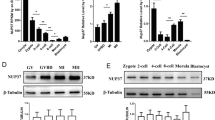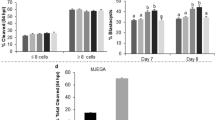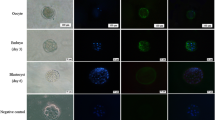Abstract
Purpose
The aim of the present study is to investigate role of FoxO transcription factors in preimplantation embryo development by knocking down FoxO1, FoxO3, and FoxO4 genes and also to assess cell cycle arrest related proteins, p53 and p21, and apoptosis-related proteins, fas ligand (FASL), and cleaved caspase 3.
Methods
Knockdown of FoxOs using siRNA was confirmed utilizing RT-PCR and qRT-PCR in gene level and using immunofluorescence in protein level. Following knockdown of FoxO1, FoxO3, and FoxO4 in two-cell mouse embryos with or without resveratrol treatment; developmental competence of embryos and expression patterns of SIRT1, p53, p21, FASL, and CLEAVED CASPASE 3 proteins in embryos by immunofluorescence were assessed after 48 h. ROS levels were measured in knockdown embryos. Terminal deoxynucleotidyl transferase dUTP nick end labeling assay was used to determine resveratrol dose.
Results
Successful knockdown of FoxO genes in mouse embryos utilizing a non-invasive siRNA method was achieved. Significantly, knockdown of FoxO genes impaired preimplantation embryo development which cannot be prevented by resveratrol treatment. Immunofluorescence results showed that resveratrol could protect embryos from cell cycle arrest and apoptosis. FOXO proteins regulate apoptosis and cell cycle related proteins in mouse preimplantation embryos. Moreover, there might be an autofeedback mechanism where FOXO1, FOXO3, and FOXO4 regulate SIRT1 protein expression.
Conclusions
These results suggest that FOXO transcription factors could contribute to mouse preimplantation embryo development, and it remains to investigate whether they have crucial roles in human preimplantation embryo and infertility.








Similar content being viewed by others
Change history
04 December 2019
The original article unfortunately contained a mistake. There is a misplaced “1” in the article title and the correct title is shown above.
References
Banks AS, Kon N, Knight C, Matsumoto M, Gutierrez-Juarez R, Rossetti L, et al. SirT1 gain of function increases energy efficiency and prevents diabetes in mice. Cell Metab. 2008;8:333–41.
Betts DH, Madan P. Permanent embryo arrest: molecular and cellular concepts. Mol Hum Reprod. 2008;14:445–53.
Brunet A, Sweeney LB, Sturgill JF, Chua KF, Greer PL, Lin Y, et al. Stress-dependent regulation of FOXO transcription factors by the SIRT1 deacetylase. Science. 2004;303:2011–5.
Chan WH. Resveratrol protects against 2-bromopropane-induced apoptosis and disruption of embryonic development in blastocysts. Int J Mol Sci. 2011;12:4991–5010.
Chen LJ, Xu WM, Yang M, Wang K, Chen Y, Huang XJ, et al. HUWE1 plays important role in mouse preimplantation embryo development and the dysregulation is associated with poor embryo development in humans. Sci Rep. 2016;6:37928.
Coffre M, Benhamou D, Riess D, Blumenberg L, Snetkova V, Hines MJ, et al. miRNAs are essential for the regulation of the PI3K/AKT/FOXO pathway and receptor editing during B cell maturation. Cell Rep. 2016;17:2271–85.
Daitoku H, Hatta M, Matsuzaki H, Aratani S, Ohshima T, Miyagishi M, et al. Silent information regulator 2 potentiates Foxo1-mediated transcription through its deacetylase activity. Proc Natl Acad Sci U S A. 2004;101:10042–7.
Delhanty JD, Harper JC, Ao A, Handyside AH, Winston RM. Multicolour FISH detects frequent chromosomal mosaicism and chaotic division in normal preimplantation embryos from fertile patients. Hum Genet. 1997;99:755–60.
Gertz M, Nguyen GT, Fischer F, Suenkel B, Schlicker C, Franzel B, et al. A molecular mechanism for direct sirtuin activation by resveratrol. PLoS One. 2012;7:e49761.
Greer EL, Brunet A. FOXO transcription factors at the interface between longevity and tumor suppression. Oncogene. 2005;24:7410–25.
Griendling KK, Berk BC, Socorro L, Tsuda T, Delafontaine P, Alexander RW. Secondary signalling mechanisms in angiotensin II-stimulated vascular smooth muscle cells. Clin Exp Pharmacol Physiol. 1988;15:105–12.
Gungor-Ordueri NE, Tang EI, Celik-Ozenci C, Cheng CY. Ezrin is an actin binding protein that regulates Sertoli cell and spermatid adhesion during spermatogenesis. Endocrinology. 2014;155:3981–95.
Hay N. Interplay between FOXO, TOR, and Akt. Biochim Biophys Acta. 2011;1813:1965–70.
Hori YS, Kuno A, Hosoda R, Horio Y. Regulation of FOXOs and p53 by SIRT1 modulators under oxidative stress. PLoS One. 2013;8:e73875.
Huang LH, Shiao NH, Hsuuw YD, Chan WH. Protective effects of resveratrol on ethanol-induced apoptosis in embryonic stem cells and disruption of embryonic development in mouse blastocysts. Toxicology. 2007;242:109–22.
Jeong JK, Kang MH, Gurunathan S, Cho SG, Park C, Park JK, et al. Pifithrin-alpha ameliorates resveratrol-induced two-cell block in mouse preimplantation embryos in vitro. Theriogenology. 2015;83:862–73.
Kawamura Y, Uchijima Y, Horike N, Tonami K, Nishiyama K, Amano T, et al. Sirt3 protects in vitro-fertilized mouse preimplantation embryos against oxidative stress-induced p53-mediated developmental arrest. J Clin Invest. 2010;120:2817–28.
Kitamura YI, Kitamura T, Kruse JP, Raum JC, Stein R, Gu W, et al. FoxO1 protects against pancreatic beta cell failure through NeuroD and MafA induction. Cell Metab. 2005;2:153–63.
Kuscu N, Celik-Ozenci C. FOXO1, FOXO3, AND FOXO4 are differently expressed during mouse oocyte maturation and preimplantation embryo development. Gene Expr Patterns. 2015;18:16–20.
Kyoung Kim H, Kyoung Kim Y, Song IH, Baek SH, Lee SR, Hye Kim J, et al. Down-regulation of a forkhead transcription factor, FOXO3a, accelerates cellular senescence in human dermal fibroblasts. J Gerontol A Biol Sci Med Sci. 2005;60:4–9.
Lam EW, Francis RE, Petkovic M. FOXO transcription factors: key regulators of cell fate. Biochem Soc Trans. 2006;34:722–6.
Langley E, Pearson M, Faretta M, Bauer UM, Frye RA, Minucci S, et al. Human SIR2 deacetylates p53 and antagonizes PML/p53-induced cellular senescence. EMBO J. 2002;21:2383–96.
Lee MT, Bonneau AR, Giraldez AJ. Zygotic genome activation during the maternal-to-zygotic transition. Annu Rev Cell Dev Biol. 2014;30:581–613.
Leese HJ. Quiet please, do not disturb: a hypothesis of embryo metabolism and viability. Bioessays. 2002;24:845–9.
Leese HJ, Donnay I, Thompson JG. Human assisted conception: a cautionary tale. Lessons from domestic animals. Hum Reprod. 1998;13(Suppl 4):184–202.
Link W, Fernandez-Marcos PJ. FOXO transcription factors at the interface of metabolism and cancer. Int J Cancer. 2017;141:2379–91.
Liu M, Yin Y, Ye X, Zeng M, Zhao Q, Keefe DL, et al. Resveratrol protects against age-associated infertility in mice. Hum Reprod. 2013;28:707–17.
Liu X, Feng J, Tang L, Liao L, Xu Q, Zhu S. The regulation and function of miR-21-FOXO3a-miR-34b/c signaling in breast cancer. Int J Mol Sci. 2015;16:3148–62.
Maiese K, Chong ZZ, Shang YC. OutFOXOing disease and disability: the therapeutic potential of targeting FoxO proteins. Trends Mol Med. 2008;14:219–27.
Mansouri L, Xie Y, Rappolee DA. Adaptive and pathogenic responses to stress by stem cells during development. Cells. 2012;1:1197–224.
Matsuzaki H, Daitoku H, Hatta M, Tanaka K, Fukamizu A. Insulin-induced phosphorylation of FKHR (Foxo1) targets to proteasomal degradation. Proc Natl Acad Sci U S A. 2003;100:11285–90.
Nasr-Esfahani MM, Johnson MH. The origin of reactive oxygen species in mouse embryos cultured in vitro. Development. 1991;113:551–60.
O’Meara CM, Murray JD, Mamo S, Gallagher E, Roche J, Lonergan P. Gene silencing in bovine zygotes: siRNA transfection versus microinjection. Reprod Fertil Dev. 2011;23:534–43.
O’Neill C. Evidence for the requirement of autocrine growth factors for development of mouse preimplantation embryos in vitro. Biol Reprod. 1997;56:229–37.
O’Neill C. Autocrine mediators are required to act on the embryo by the 2-cell stage to promote normal development and survival of mouse preimplantation embryos in vitro. Biol Reprod. 1998;58:1303–9.
Obsil T, Obsilova V. Structure/function relationships underlying regulation of FOXO transcription factors. Oncogene. 2008;27:2263–75.
Qiao L, Shao J. SIRT1 regulates adiponectin gene expression through Foxo1-C/enhancer-binding protein alpha transcriptional complex. J Biol Chem. 2006;281:39915–24.
Riley JK, Carayannopoulos MO, Wyman AH, Chi M, Ratajczak CK, Moley KH. The PI3K/Akt pathway is present and functional in the preimplantation mouse embryo. Dev Biol. 2005;284:377–86.
Rodriguez R, Meuth M. Chk1 and p21 cooperate to prevent apoptosis during DNA replication fork stress. Mol Biol Cell. 2006;17:402–12.
Sin TK, Yung BY, Siu PM. Modulation of SIRT1-Foxo1 signaling axis by resveratrol: implications in skeletal muscle aging and insulin resistance. Cell Physiol Biochem. 2015;35:541–52.
Singhal R, Bard JE, Nowak NJ, Buck MJ, Kandel ES. FOXO1 regulates expression of a microRNA cluster on X chromosome. Aging (Albany NY). 2013;5:347–56.
Su WH, Wong EWP, Mruk DD, Cheng CY. The scribble/Lgl/Dlg polarity protein complex is a regulator of blood-testis barrier dynamics and spermatid polarity during spermatogenesis. Endocrinology. 2012;153:6041–53.
Tothova Z, Kollipara R, Huntly BJ, Lee BH, Castrillon DH, Cullen DE, et al. FoxOs are critical mediators of hematopoietic stem cell resistance to physiologic oxidative stress. Cell. 2007;128:325–39.
Tuteja G, Kaestner KH. Forkhead transcription factors II. Cell. 2007a;131:192–192.e1.
Tuteja G, Kaestner KH. SnapShot: forkhead transcription factors I. Cell. 2007b;130:1160.
Tzivion G, Dobson M, Ramakrishnan G. FoxO transcription factors; regulation by AKT and 14-3-3 proteins. Biochim Biophys Acta. 2011;1813:1938–45.
Urbanek P, Klotz LO. Posttranscriptional regulation of FOXO expression: microRNAs and beyond. Br J Pharmacol. 2017;174:1514–32.
van der Horst A, Tertoolen LG, De Vries-Smits LM, Frye RA, Medema RH, Burgering BM. FOXO4 is acetylated upon peroxide stress and deacetylated by the longevity protein hSir2(SIRT1). J Biol Chem. 2004;279:28873–9.
Wang F, Tian X, Zhang L, He C, Ji P, Li Y, et al. Beneficial effect of resveratrol on bovine oocyte maturation and subsequent embryonic development after in vitro fertilization. Fertil Steril. 2014;101:577–86.
Watroba M, Maslinska D, Maslinski S. Current overview of functions of FoxO proteins, with special regards to cellular homeostasis, cell response to stress, as well as inflammation and aging. Adv Med Sci. 2012;57:183–95.
Xiong S, Salazar G, Patrushev N, Alexander RW. FoxO1 mediates an autofeedback loop regulating SIRT1 expression. J Biol Chem. 2011;286:5289–99.
Xue Z, Huang K, Cai C, Cai L, Jiang CY, Feng Y, et al. Genetic programs in human and mouse early embryos revealed by single-cell RNA sequencing. Nature. 2013;500:593–7.
Yun JM, Chien A, Jialal I, Devaraj S. Resveratrol up-regulates SIRT1 and inhibits cellular oxidative stress in the diabetic milieu: mechanistic insights. J Nutr Biochem. 2012;23:699–705.
Zhao DC, Li YM, Ma JL, Yi N, Yao ZY, Li YP, et al. Single-cell RNA sequencing reveals distinct gene expression patterns in glucose metabolism of human preimplantation embryos. Reprod Fertil Dev. 2019;31:237–47.
Funding
This study was supported by The Scientific and Technological Research Council of Turkey (TUBITAK) with grant number: 114S384.
Author information
Authors and Affiliations
Corresponding author
Ethics declarations
The experimental protocol was approved by the local ethical committee (number of the ethical approval 2014.04.04)
Conflict of interest
The authors declare that they have no conflict of interest.
Additional information
Publisher’s note
Springer Nature remains neutral with regard to jurisdictional claims in published maps and institutional affiliations.
Electronic supplementary material
Supplement 1.
List of siRNA duplexes used in the study. (DOCX 176 kb)
Supplement 2.
List of PCR primers used in the study. (PDF 40 kb)
Supplement 3.
In FoxO1 knockdown group two embryos are side by side in the same culture drop (after 48 h). Two cell embryos which were transfected both with FoxO1 siRNA and siGLO were cultured for 48 h. At the end of the experiment, one of them developed to blastocyst stage (lower left) and expressed very high level of FoxO1 protein (green fluorescent). There was no siGLO (red fluorescent) signal in its blastomeres except a nonspecific retention of siGLO by polar body (arrowhead) can be seen. The other embryo which arrested at 2-cell stage (upper central) expressed very low level (almost none) of FoxO1 protein (green fluorescent). Lots of siGLO (red fluorescent) signal in its blastomeres can be seen as little red dots. White arrows indicate the siGLO signals in arrested 2-cell embryo. Transfection with siRNA around cell nucleus (perinuclear) which is indicated by red siGLO signal (circle) can be seen in image with higher magnification (upper right image). (PNG 804 kb)
Supplement 4.
Resveratrol (RVT) dose was determined utilizing TUNEL method. According to our results, RVT doses higher than 0.5 μM lead to increased cell death in blastocysts. A) Representative images of TUNEL-labeled blastocysts in control, DMSO (vehicle-control), 0.5 μM RVT, 1 μM RVT, and 2 μM RVT treated groups (n = 20). Red signal indicates TUNEL-positive staining and the blue signal (DAPI) indicates the nuclei of the embryonic cells. B) Total number of cells per embryo were counted in the all groups. Embryos treated with 0.5 μM RVT contained more cells (p = 0.01) when compared to controls. Blastocysts cultured in presence of 2 μM RVT displayed a significant increase in the percentage of TUNEL-positive cells when compared to controls (p = 0.044) and to 0.5 μM RVT treated embryos, respectively (p = 0.015). Dose of resveratrol has been determined as 0.5 μM considering TUNEL results. (PNG 2859 kb)
Rights and permissions
About this article
Cite this article
Kuscu, N., Gungor-Ordueri, N.E., Sozen, B. et al. FoxO transcription factors 1 regulate mouse preimplantation embryo development. J Assist Reprod Genet 36, 2121–2133 (2019). https://doi.org/10.1007/s10815-019-01555-1
Received:
Accepted:
Published:
Issue Date:
DOI: https://doi.org/10.1007/s10815-019-01555-1




